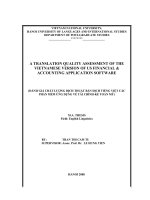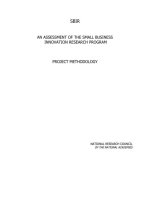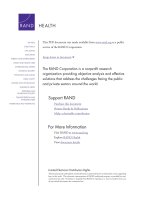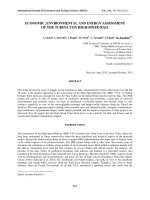Comparative assessment of the genetic variatio
Bạn đang xem bản rút gọn của tài liệu. Xem và tải ngay bản đầy đủ của tài liệu tại đây (458.16 KB, 3 trang )
onlinelibrary.wiley.com
Comparative assessment of the genetic
variation in selectively bred generations from
two geographic populations of ivory shell
(Babylonia areolata) - Fu - 2017 Aquaculture Research
Jingqiang Fu
3-4 phút
Original Article
Comparative assessment of the genetic variation in
selectively bred generations from two geographic
populations of ivory shell (Babylonia areolata)
Xuan Luo
College of Ocean and Earth Sciences, Xiamen University, Xiamen, China
Fujian Collaborative Innovation Center for Exploitation and Utilization of Marine Biological
Resources, Fujian, China
Search for more papers by this author
Caihuan Ke
College of Ocean and Earth Sciences, Xiamen University, Xiamen, China
Fujian Collaborative Innovation Center for Exploitation and Utilization of Marine Biological
Resources, Fujian, China
State Key Laboratory of Marine Environmental Science, Xiamen University, Xiamen, China
Search for more papers by this author
Weiwei You
Corresponding Author
E-mail address:
College of Ocean and Earth Sciences, Xiamen University, Xiamen, China
Fujian Collaborative Innovation Center for Exploitation and Utilization of Marine Biological
Resources, Fujian, China
State Key Laboratory of Marine Environmental Science, Xiamen University, Xiamen, China
Correspondence: W You, College of Ocean and Earth Sciences, Xiamen University, Xiamen
361102, China. E‐mail:
Search for more papers by this author
First published: 08 December 2016
Cited by: 2
Abstract
Ivory shell, Babylonia areolata, is one of the commercially important mariculture species in
southern China and South‐East Asia. The selection programme for growth trait has been
conducted since 2010 in two selected lines for three generations, namely the Hainan (H) and
Thailand (T) selected lines. Ten polymorphic microsatellite loci were used to monitor changes in
their genetic diversity and structure during the selection process. A relatively high level of
overall genetic diversity was observed, while the number of microsatellite allele declined slightly
in the mass selection lines. Comparative diversity estimates indicated greater genetic diversity in
H line than T line. Moreover, a relatively weak but significant genetic differentiation was found
in both of the selected generations. In addition, the higher genetic variation observed in H line is
most likely caused by artificial selection while selection bias on a growth advantage for the T
population. These findings suggest no significant decline of genetic diversity was observed in the
presently selected lines and that a potential exists for genetic improvement and development for
B. areolata.









